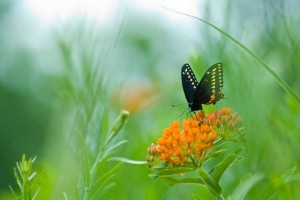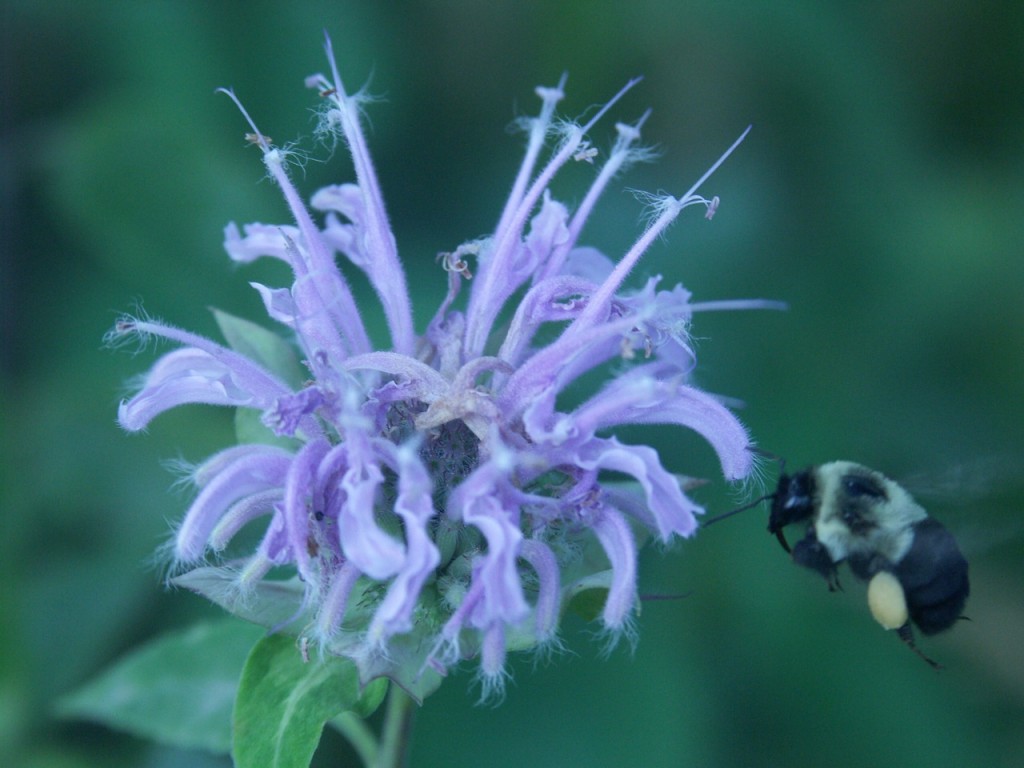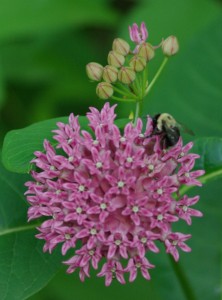Bees and Pollinators Hard at Work for Us
Consider for a moment that one out of every four mouthfuls of food and beverage that you consume requires the presence of an insect pollinator. The United States alone grows 130 crop plants that need insect pollinators. The economic value of directly pollinated crops in the United States in 2010 was estimated at $27 billion. If you consider the value of indirect pollinator benefits — such as milk and beef cattle fed on pollinator-dependent alfalfa — $40 billion worth of agricultural products each year in this country are produced only through the work of insect pollinators.
Without the services of insect pollinators we would not have apples, pears, cherries, squashes, watermelons, blueberries, carrots, broccoli, almonds, blackberries, tomatoes, orange juice, coffee, or chocolate.
In fact 75% of all the fruit and vegetables we consume depend on pollinators. Pollinators are directly or indirectly responsible for many juice-based beverages, fibers (especially cotton and flax), and oil crops such as canola and sunflower, which are increasingly being used for biofuel production.

Swallowtail butterfly nectaring on butterfly weed. Photo courtesy Tom Rollins, ThomasRollinsPhotography.com.
We should also not overlook that insect pollinators are responsible for fertilizing many of the plants and trees, both in our natural areas and in our gardens, which provide each year’s spectacular flowers.
But the work of pollinators has value beyond providing food and beautiful blooms for people. Pollinators help keep plant communities healthy and productive. When pollinators are lost, bushes and trees may continue to flower and look normal for a decade, but they cannot reproduce themselves, and in time will simply go away. Pollinators are not only essential to plant reproduction, but they help plants and people in other ways as well.
The larva of some insect pollinators, for example, bore holes in dead or weakened trees initiating quickened decay and returning nutrients locked away in trees’ wood back into soil to be used by other plants. Pollinators also help plant communities stabilize soil, preventing erosion and improving groundwater quality. Willows, common along our creek sides, are a good example. Willows have male trees and female trees and require insects to cross-pollinate for production of new starts. And willows are the prime soil stabilizers along our bluffland waterways. Goldenrods are another good example. The insect pollinated plant quickly colonizes disturbed ground and helps to prevent soil erosion.
Many of our local animals also depend on insect pollinators. In late summer, insect pollinated fruits account for much of the diet of many local mammals and the vast majority of local birdlife. And, the pollinating insects themselves, a critical part of the overall food web, at some point in their life stages become food for about 90% of our bird species.
Insect pollinators don’t gather pollen with the intent of promoting plant reproduction. They are animals looking for food, and they’ve found the sweet nectar and fatty, protein-rich pollen to be excellent foods for themselves or their young. They also may be looking for mates, sometimes meeting at flowers where they gather food, or in other cases collecting floral oils to use as perfumes to attract a mate. As pollinators feed, court or gather oils, pollen grains stick to their bodies and rub off accidentally when they visit other blossoms.
Bees are the most important group of pollinators. In addition to our long-ago-imported European honeybee, which now are in serious decline across America, Southwestern Illinois hosts nearly 300 species of native bees. With the exception of a few species of wasps, only bees deliberately gather pollen to bring back to their nests for their offspring. Bees also exhibit a behavior called “flower constancy.” They repeatedly visit one particular plant species on any given foraging trip. This is important because pollen is wasted if it is delivered to the wrong species of flower. On a single foraging trip, a single female bee may visit hundreds of flowers, transferring pollen the entire way.
Other insect pollinators in our area include butterflies (100 local species), moths (1200 local species), and innumerable species of flies, wasps and beetles. In contrast to bees, butterflies, moths, flies, wasps and beetles visit flowers to feed on nectar and not to collect pollen. Thus, they come in contact less frequently with the flower anthers than bees do, but are nonetheless an important agent in the pollination process.
In recent decades many insect pollinator species have gone into serious decline. Changes in agricultural practices, habitat loss, improper pesticide use, disease caused by introduced exotic plant and animal species, and our warming climate have all contributed to a reduction in the number of insect pollinators, and have negatively impacted the overall availability of pollinators for important segments of agribusiness, horticulture, gardeners, and landowners.
Clifftop hosted a “Pollinator Conservation Seminar” on Saturday, August 24th, 2013 to learn about and discuss improving natural habitats, gardens and landscapes to attract pollinators and sustain healthy populations of insect pollinators. The seminar was presented by Leslie Deem, Pollinatarium Director at the University of Illinois – Urbana. U of I’s Pollinatarium is the first science center in the nation devoted to flowering plants and their pollinators. The seminar was another in the continuing series “Meet the Neighbors” co-hosted by the Monroe-Madison-St. Clair unit of the University of Illinois Extension Service and Clifftop.
CLIFFTOP, a local nonprofit organization, is focused on preserving and protecting area bluff lands.
A version of this article appeared in the 2 August 2013 edition of the Monroe County Independent.
© 2013 all content rights reserved Clifftop NFP.
Comments are currently closed.


